Weekly Recap
Stocks rebounded last week in a holiday-shortened week but faced some selling pressure later on in the week, finishing below their best levels. The Nasdaq posted the strongest gains, up 2% across the week, while the S&P 500 gained 1.88% and the Dow Jones rose 1.6%.
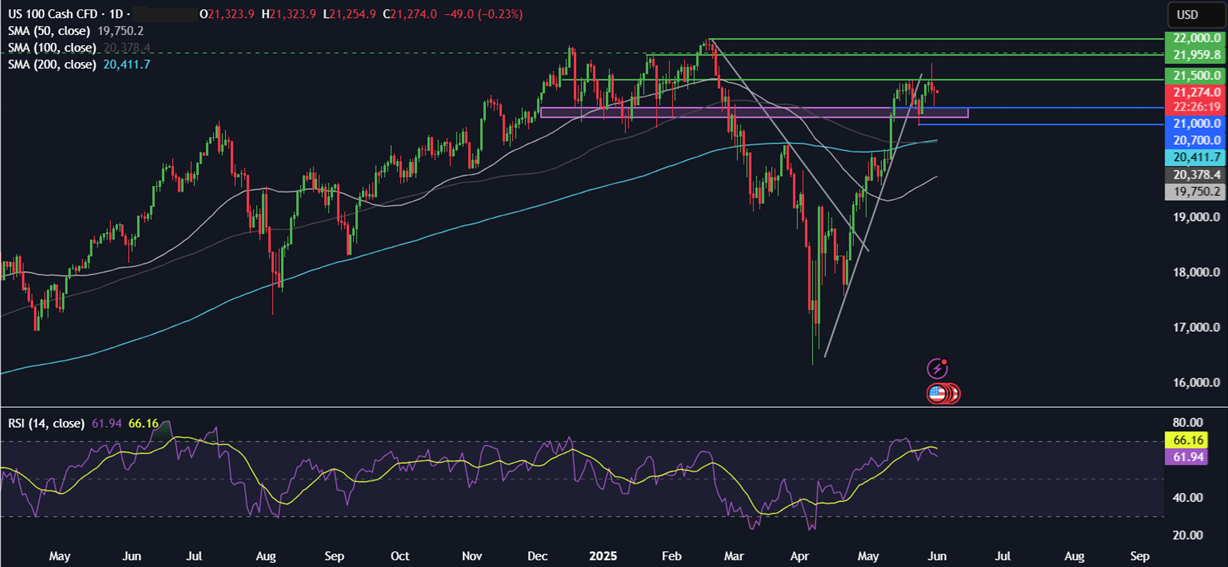
Stocks rose after President Trump said he would delay introducing a 50% tariff on imports from the European Union, announced 2 days before, until July 9th, and that negotiations would be fast-tracked. Later in the week, the U.S. Court of International Trade ruled that Trump had no authority to impose many of the trade tariffs since the start of his second term, which sent stocks sharply higher on Thursday. However, this was overturned by the appeals court, which, along with comments from Treasury Secretary Scott Bessent, said that US-China trade talks were stalled and weighed on the mood at the end of the week.
On the data front, the Federal Reserve’s preferred gauge for inflation rose 2.5% in April, down from 2.7% in March, marking the lowest annual reading since 2021. Despite this cooling, expectations are for inflation to pick up later in the summer due to the impact of tariffs.
Trump trade tariff developments
Trump trade tariff developments remain a key focus, with the market still headline-driven. Over the weekend. Trump announced that the US will double steel import tariffs to 50% as of Wednesday of this week, replacing the 25% import tariffs that the US president had announced earlier this year. The EU has warned that it is prepared to impose retaliatory measures against the US and that this latest development undermines ongoing efforts to reach a negotiated solution. The ongoing uncertainties surrounding Trump’s tariffs could help support safe-haven flows and raise gold prices.

OPEC+ meeting (Saturday)
Oil prices will be in focus at the start of the week after OPEC+, a group of the world’s largest oil producers, announced another big increase of 411,000 barrels per day for July. After years of curbing production, OPEC+ modestly increased output in April before tripling it in May, June, and July. The moves by the group, which is led by Saudi Arabia and includes Russia, seek to win back market share by punishing overproducing allies. The move comes as the demand outlook deteriorates owing to expected slower growth, Trump’s trade policies impact the GDP outlook for the US and China, the world’s largest oil consumers.
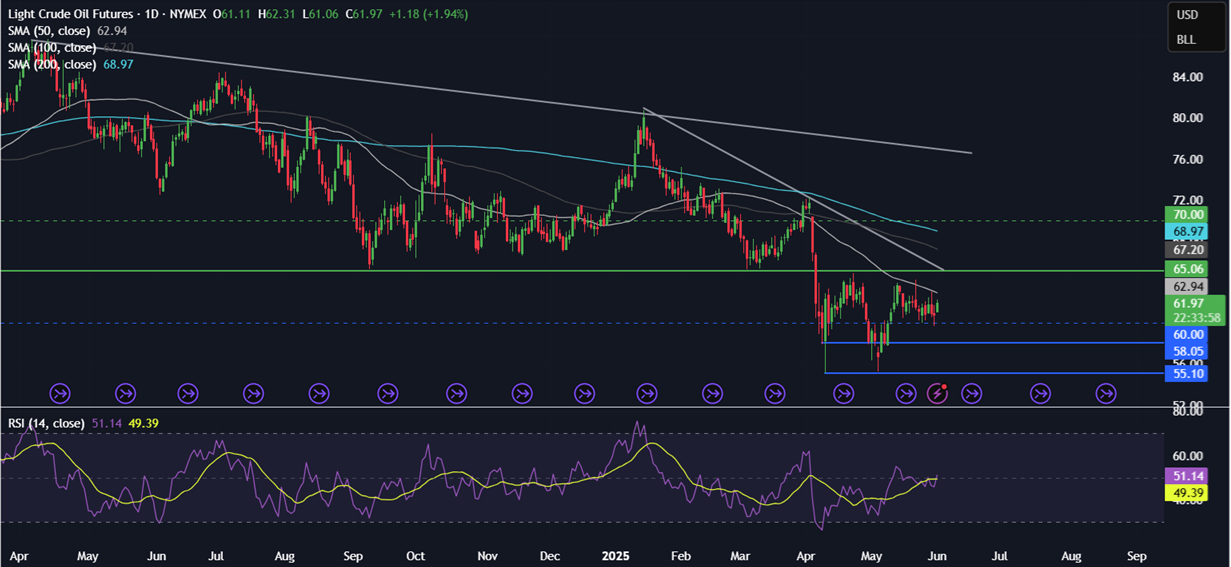
ISM manufacturing PMI (Monday)
Expectations are for ISM manufacturing to remain unchanged in May at 48.7. The S&P Global flash US manufacturing PMI could be considered a good point of comparison, which rose to a three-month high of 52.3, up from 50.2 in April. The report noted that the improved performance was amid faster growth in new orders, with manufacturing inflows rising at the sharpest pace for 15 months. Manufacturing selling prices also increased sharply, booking the largest monthly increase in September 2022, and confidence about the outlook reached its highest level in three months. This data point will be very much in focus in light of Trump’s erratic trade policies as he aims to increase manufacturing in the US. Strong data could boost USD and US equities, such as the Dow Jones.
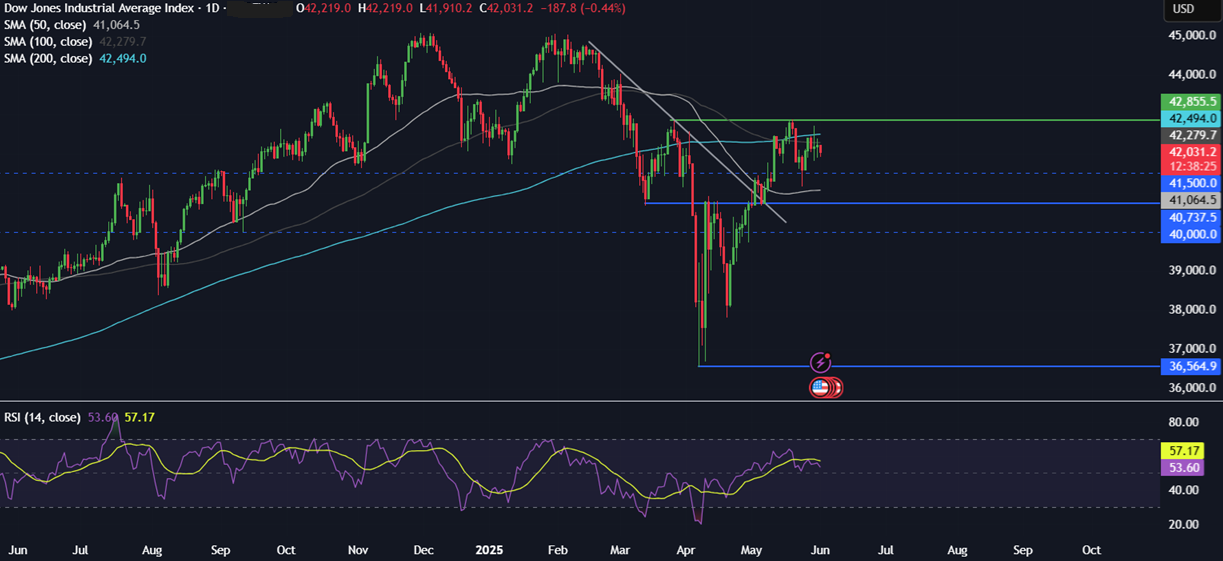
US ISM services (Wednesday)
Expectations are for the ISM services PMI to tick higher to 52 in May, up from 51.6 in April. Using the S&P Global Services PMI in May as a point of comparison, this rose to 52.3, up from 50.8, marking a 2-month high. Prices charged for services rose to a level not seen since August 2022. Domestic demand has been the strongest since March, as exports of goods and services fell for the second straight month due to Trump’s trade policies. Given that there are still lingering concerns over the economic outlook for the US in light of Trump’s erratic trade policies, the data will be watched closely. Any sense of weakness in the service sector, the US economy’s dominant sector, could fuel concerns over the outlook, pulling equities and the US dollar lower. This could boost GBP/USD towards multi-year highs.
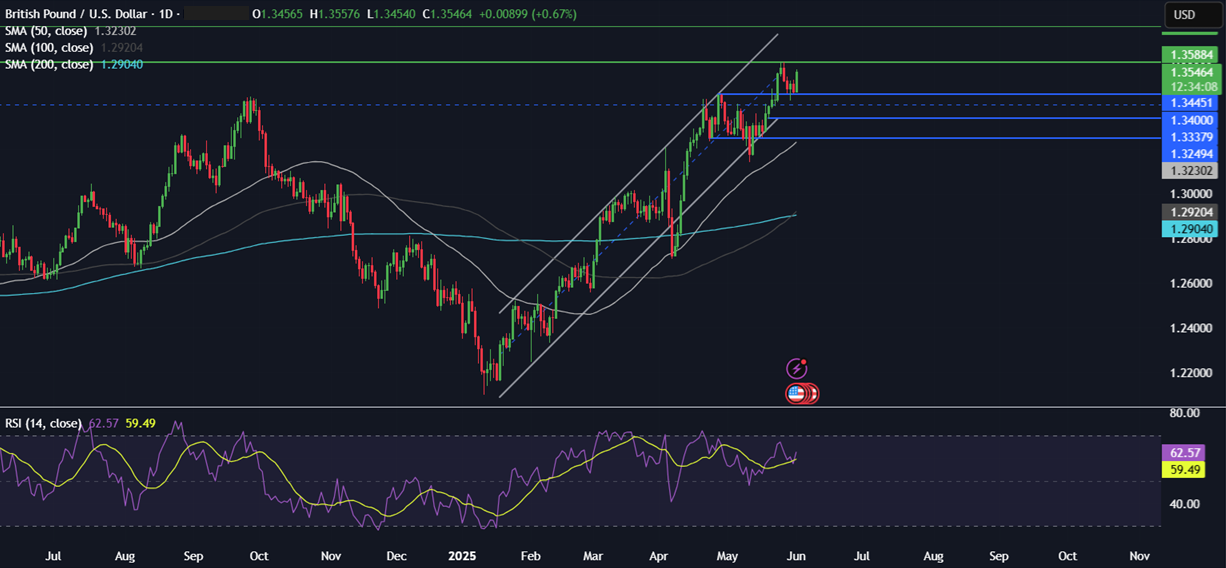
BoC rate decision (Wednesday)
Amid a de-escalation in US-Canada trade tensions, PM Mark Carney is focusing on stimulating the domestic economy and sticky inflation, the Bank of Canada is likely to leave interest rates unchanged in the meeting on June 4. The market is pricing in a 70% likelihood of rates remaining at 2.75%. This comes after the central bank has cut policy rates seven times since beginning its easing cycle last summer and pausing at its April meeting.
Outlook in Canada remains murky. Core inflation remains sticky, surprising to the upside in April, diverging from headline inflation, which continues to ease. The labour market is weakening, which the BoC will watch. A key focus will be trade policy uncertainty and its economic impact. The BoC will likely want to see how the effects of the US and Canada’s retaliatory tariffs play out before moving again. The market is pricing in around 40 basis points of cuts before the end of the year. Should the BoC sound cautious about the outlook of the Canadian economy, USD/CAD could rise.
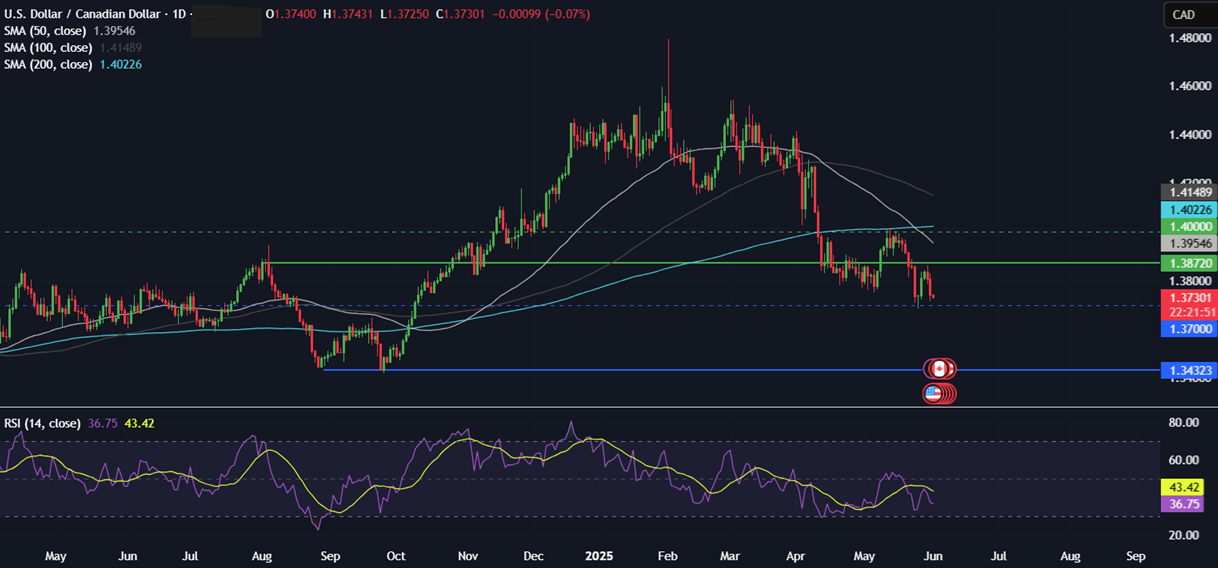
ECB rate decision (Thursday)
After the April ECB meeting minutes showed dovish unity between policymakers, the June meeting is looking more divided. The broad expectation is that policymakers will cut interest rates by a further 25 basis points, taking the deposit rate to 2%. However, the hawks at the ECB are starting to sound cautious, suggesting a pause in rate cuts until at least September, given the simmering EU-U.S. trade war. Austrian central bank governor Robert Holtzman said he saw no reason for the ECB to lower rates in its June-July meetings. However, his hawkish comments disagree with other ECB doves considering a 25 basis point rate cut necessary to support the economy, owing to bleak growth forecasts and inflation cooling towards the central bank’s 2% target. Trade concerns will be a key consideration given that Trump has set a deadline of July 9th for 50% trade tariffs. Should the ECB raise concerns over the outlook, EUR/USD could fall.

Non-farm payrolls (Friday)
Expectations are for 130k jobs to be added in May (versus 177k added in April). The 3-month average is 155k. The unemployment rate is expected to remain at 4.2%, while the Fed forecasts unemployment rising to 4.4% this year. Average hourly wages are expected to rise 0.3%, up from 0.2% in April. The markets will be watching closely amid expectations that the labour market outlook is deteriorating owing to President Trump’s tariff policies, which are increasing economic uncertainty. US initial jobless claims ticked up to 240K last week, and investors will be watching the employment component in the ISM reports this week and ADP payroll for clues over what to expect. Whilst the recent FOMC meeting minutes noted that the risks of higher inflation and higher employment have risen recently, it may still be too early for any impact to show in the data. Should the US non-farm payroll come weaker than expected, fueling concerns over the economic outlook, the US dollar could fall, and the safe-haven Japanese yen may push higher, pulling USD/JPY lower.
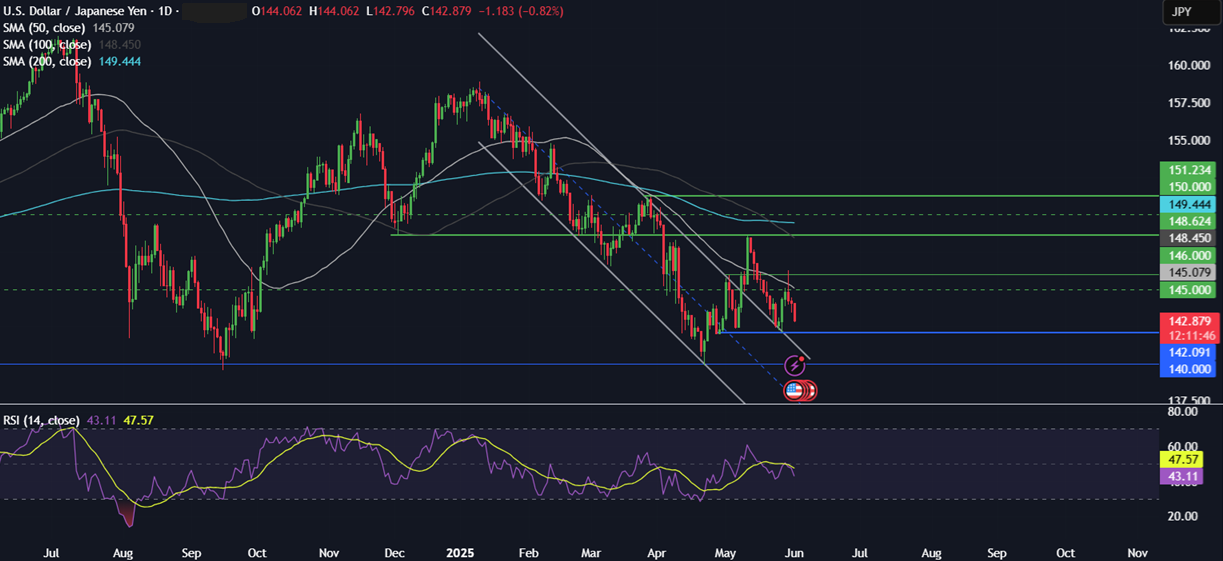
Trading involves risk.
The content provided here is for informational purposes only. It is not intended as personal investment advice and does not constitute a solicitation or invitation to engage in any financial transactions, investments, or related activities. Past performance is not a reliable indicator of future results.
The financial products offered by the Company are complex and come with a high risk of losing money rapidly due to leverage. These products may not be suitable for all investors. Before engaging, you should consider whether you understand how these leveraged products work and whether you can afford the high risk of losing your money.
The Company does not accept clients from the Restricted Jurisdictions as indicated in our website/ T&C. Some services or products may not be available in your jurisdiction.
The applicable legal entity and its respective products and services depend on the client’s country of residence and the entity with which the client has established a contractual relationship during registration.




